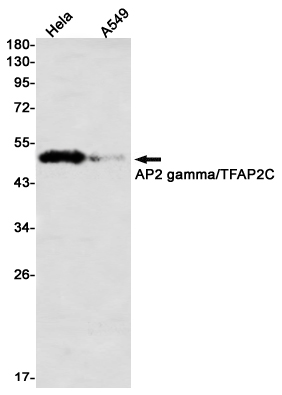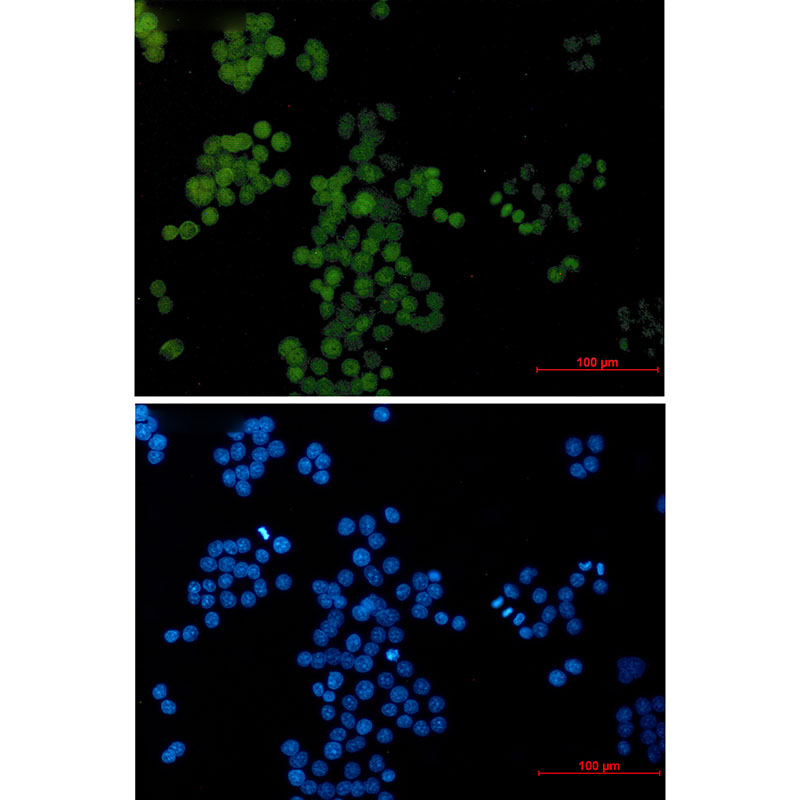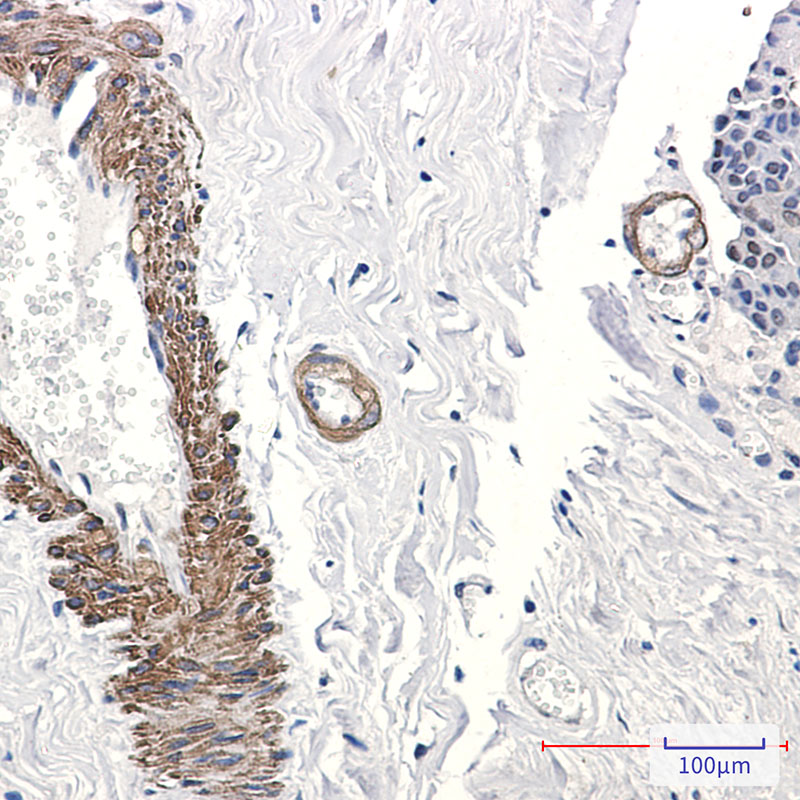


| WB | 1/500-1/1000 | Human,Mouse,Rat |
| IF | 咨询技术 | Human,Mouse,Rat |
| IHC | 1/50-1/100 | Human,Mouse,Rat |
| ICC | 1/50-1/200 | Human,Mouse,Rat |
| FCM | 咨询技术 | Human,Mouse,Rat |
| Elisa | 咨询技术 | Human,Mouse,Rat |
| Aliases | ERF1; TFAP2G; hAP-2g; AP2-GAMMA |
| Entrez GeneID | 7022 |
| WB Predicted band size | Calculated MW: 49 kDa; Observed MW: 49 kDa |
| Host/Isotype | Rabbit IgG |
| Antibody Type | Primary antibody |
| Storage | Store at 4°C short term. Aliquot and store at -20°C long term. Avoid freeze/thaw cycles. |
| Species Reactivity | Human |
| Immunogen | A synthetic peptide of human AP2 gamma/TFAP2C |
| Formulation | Purified antibody in TBS with 0.05% sodium azide,0.05%BSA and 50% glycerol. |
+ +
以下是关于Transcription Factor AP-2γ(TFAP2C)抗体的3篇参考文献概览:
1. **文献名称**:*"TFAP2C regulates proliferation and mitochondrial functions in breast cancer"*
**作者**:Cyril Sarkis, et al.
**摘要**:该研究利用AP-2γ抗体通过免疫组化和Western blot分析,揭示了TFAP2C在乳腺癌细胞增殖和线粒体代谢中的关键作用,证明其高表达与肿瘤侵袭性相关。
2. **文献名称**:*"Essential role of TFAP2C in mouse embryonic germ cell maintenance"*
**作者**:M. Moser, et al.
**摘要**:通过AP-2γ抗体的免疫荧光染色,研究证实TFAP2C是小鼠胚胎生殖细胞存活和分化的必需因子,敲除后导致生殖细胞凋亡和发育异常。
3. **文献名称**:*"AP-2γ regulates oocyte-specific gene expression in early embryonic development"*
**作者**:P. Kuckenberg, et al.
**摘要**:研究使用AP-2γ抗体进行ChIP-seq和基因敲除实验,发现TFAP2C通过结合卵母细胞特异性基因启动子调控早期胚胎发育中的基因表达网络。
4. **文献名称**:*"TFAP2C-driven chromatin looping enhances oncogenic signaling in luminal breast cancer"*
**作者**:J. Pellikainen, et al.
**摘要**:通过AP-2γ抗体的染色质免疫共沉淀(ChIP)分析,揭示了TFAP2C通过形成染色质环结构激活雌激素受体信号通路,促进管腔型乳腺癌进展。
以上文献涵盖癌症、胚胎发育及表观遗传调控方向,均明确应用AP-2γ抗体进行功能或机制研究。
Transcription Factor AP-2 gamma (TFAP2C), encoded by the *TFAP2C* gene, is a member of the AP-2 family of DNA-binding transcription factors, which includes five isoforms (AP-2α to AP-2ε). AP-2 gamma plays critical roles in embryonic development, particularly in the regulation of gene expression during the formation of neural crest-derived tissues, epidermal differentiation, and placental development. It functions as a sequence-specific DNA-binding protein, often forming homodimers or heterodimers with other AP-2 family members to modulate target gene transcription. AP-2 gamma is also implicated in cell proliferation, apoptosis, and differentiation pathways.
In research, antibodies targeting AP-2 gamma are widely used to study its expression, localization, and function in both normal and pathological contexts. For example, AP-2 gamma is overexpressed in certain cancers, including breast and ovarian carcinomas, where it may act as an oncogene by promoting cell survival and inhibiting apoptosis. The antibody is employed in techniques such as Western blotting, immunohistochemistry (IHC), immunofluorescence (IF), and chromatin immunoprecipitation (ChIP) to investigate its role in tumorigenesis, stem cell biology, and reproductive health. Commercial AP-2 gamma antibodies are typically validated for specificity and sensitivity across species (human, mouse, rat), with applications spanning basic research and clinical biomarker studies. Proper controls, such as knockout cell lines or siRNA-mediated knockdown, are recommended to confirm antibody specificity in experimental settings.
×